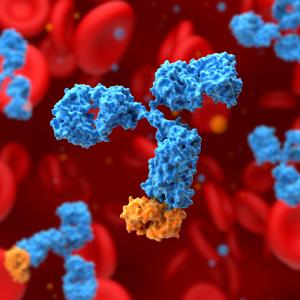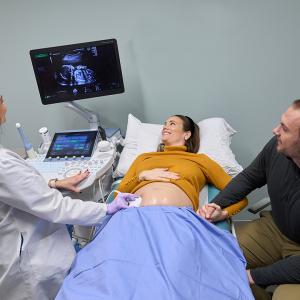
Dr. Johannes Nowatzky’s research investigates Behcet’s syndrome risk factors and its molecular drivers.
Photo: Karsten Moran
The Division of Rheumatology at NYU Langone Health has long been known as a regional, national, and international referral center for Behcet’s syndrome. A National Institutes of Health (NIH) research grant awarded to Johannes Nowatzky, MD, assistant professor of medicine and leader of the division’s Behcet’s syndrome and inflammatory eye disease program, has now helped the Behcet’s Syndrome Center claim another distinction as one of the only federally funded sites working to unlock Behcet’s syndrome intricate disease mechanisms.
Clarifying the Contributions of Two Gene Variants
Behcet’s uveitis, which strikes about 50 to 70 percent of people with Behcet’s disease, is a severe form of eye inflammation that can lead to blindness in both eyes if not treated. “Behcet’s disease has a lot of potential to cause morbidity, and even mortality through other disease manifestations, like involvement of the central nervous system or large blood vessels,” Dr. Nowatzky says. More common in Turkey, Iran, Israel, and other parts of the world, the disease has received relatively little attention by researchers in the United States.
To help clarify Behcet’s syndrome risk factors and molecular drivers, Dr. Nowatzky’s NIH-funded immunology research focuses on two polymorph genes that have been epidemiologically linked to an increased risk. One, known as HLA-B*51, encodes a variant of the human leukocyte antigen (HLA) molecule that regulates immune function. Although the HLA-B*51 variant has long been associated with Behcet’s syndrome—it increases the risk 3- to 4-fold and is found in about 70 to 80 percent of all patients —researchers haven’t understood why.
In 2013, a group of NIH researchers working with collaborators in Turkey discovered that a variant of a second gene called ERAP1, which encodes an enzyme known as endoplasmic reticulum amino peptidase 1, may further elevate the disease risk through epistasis with HLA-B*51. In individuals who carry HLA-B*51, a group of polymorphisms within ERAP1, called Hap10, yields an 11-fold increase in the risk for Behcet’s syndrome. “It confers the strongest risk that we currently know of,” Dr. Nowatzky says.
As part of the major histocompatibility (MHC) class I antigen presentation pathway, the ERAP1 enzyme trims peptides for a proper fit in the binding groove of HLA molecules such as HLA-B51. The bound peptides can then be presented on the cell surface—a key step in T cell recognition and activation. Although ERAP1 normally cuts to a 9-mer target, the Hap10 variant’s low enzymatic activity results in insufficient trimming and overly long peptides.
Dr. Nowatzky hypothesizes that packaging of longer peptides in HLA molecules, including HLA-B51, alters the immune response in a way that can lead to Behcet’s syndrome and its characteristic uveitis. To study the potential contribution of ERAP1 and HLA-B*51, his lab is using CRISPR-Cas9 genome editing to knock out or modify the peptidome changes, meaning all of the proteins that are bound to HLA-B51,” Dr. Nowatzky says. “Then we look at how these genetically modified cells behave with other cells they are supposed to stimulate or to inhibit, especially CD8 T cells.”
The researchers are also comparing the immune phenotypes of patients with severe Behcet’s syndrome from Turkey and the U.S. who carry the ERAP1 Hap10 risk variant with those who don’t and with healthy individuals. With cells collected from the anterior chamber of the eye, additional research is characterizing T cell antigen specificities to understand which molecules they bind and how ERAP1 mutations alter that activity.
Behcet’s Syndrome Risk Variants May Shift Patients’ Immune Response
So far, the research has suggested that even patients who are heterozygous for ERAP1 Hap10 have an altered immune phenotype characterized by shifts in their CD8 T cell, CD8 natural killer T (NKT) cell, and natural killer (NK) cell compartments. “This risk variant may have a larger clinical significance than we thought in the beginning, because patients who are homozygous for this genetic alteration are quite rare—they make up only 5 to 10 percent of the patients who are HLA-B*51 carriers,” Dr. Nowatzky says. “Ones who are heterozygous for ERAP1 Hap10 are much more common, about 30 to 40 percent.”
In cells with an ERAP1 knockout, he adds, “We see that this really shifts the HLA class I peptidome towards the presentation of longer peptides compared to what the case is when you have a fully functional ERAP1.” Consistent with his hypothesis, co-culture experiments suggest that the alteration changes the immune response as measured by CD8 T cell function, activation, and proliferation.
“With this project, we may be able to find a mechanistic explanation that allows us to understand how HLA-B*51 mediates this disease in a certain subset of patients,” Dr. Nowatzky says. Connecting the dots will be important for designing therapies tailored for that patient subgroup. “The bigger picture is that if you understand one mechanism well—one that drives this disease for a subgroup of people—it will very likely propel your understanding for other subgroups of patients too,” he says.
The new research grant, Dr. Nowatzky says, is a welcome validation of his decision to pursue a difficult line of inquiry into a complex, multisystem disease that has been widely misunderstood by many rheumatologists and ophthalmologists. By deciphering the molecular mechanisms of Behcet’s uveitis, he says, the effort may lead to a better grasp of its origins, methods for risk-stratifying patients, and the means to reduce its damaging effects via targeted therapies.

